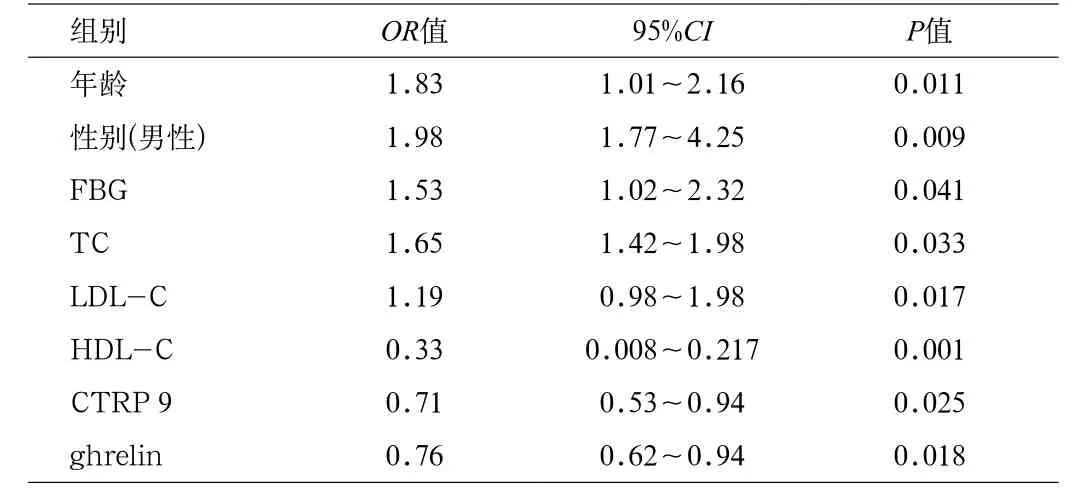瑞舒伐他汀对冠心病患者血清CTRP9及ghrelin水平的影响
王剑锋
(淳安县中医院 内科,浙江 杭州 311700)
瑞舒伐他汀对冠心病患者血清CTRP9及ghrelin水平的影响
王剑锋
(淳安县中医院 内科,浙江 杭州 311700)
目的探讨冠心病患者血清脂肪细胞因子C1 q/肿瘤坏死因子相关蛋白9(C1 q/TNF-related protein, CTRP 9)及生长素释放肽(glrelin)水平与疾病的关系,并观察使用瑞舒伐他汀治疗后两者水平的变化。方法选择120例冠心病患者和80名正常对照者,检测2组血清CTRP9及ghrelin水平。120例冠心病患者进一步随机分为常规治疗组和瑞舒服他汀组,后者在常规治疗基础上,加服瑞舒伐他汀10 mg/d,治疗4周后观察2患者血清CTRP9及glrelin水平。结果与正常对照组相比,冠心病患者血清CTRP9及glrelin水平显著降低(P<0.05),Logistic回归分析表明,血清CTRP9及glrelin是冠心病的独立保护因子。治疗4周后,瑞舒伐他汀组血清CTRP9及glrelin水平较治疗前显著升高(P<0.05),而常规治疗组其血清水平无明显变化。结论冠心病患者血清 CTRP9及glrelin水平明显降低,二者是冠心病独立的保护因素,瑞舒伐他汀可升高冠心病血清CTRP9及glrelin水平。
冠心病;瑞舒伐他汀;生长素释放肽;脂肪细胞因子C1 q/肿瘤坏死因子相关蛋白9
脂肪细胞因子C1 q/肿瘤坏死因子相关蛋白9(C1 q/ TNF-related protein, CTRP 9) 是一种新发现的与脂联素高度同源的脂肪细胞因子,多由脂肪组织合成分泌,也可部分来源于心血管组织,在调节机体代谢、保护心肌、舒张血管和改善内皮功能等发面发挥重要作用[1-2]。生长素释放肽(ghrelin)是生长激素促分泌素受体(GHS-R)的内源性配体,与GHS-R结合后发挥促生长激素分泌及调节能量代谢作用[3]。近年研究发现,ghrelin具有保护心血管系统、对抗动脉粥样硬化的作用[4]。本研究旨在探讨CTRP9与 glrelin水平与冠心病的关系,并观察瑞舒伐他汀对冠心病患者血清CTRP9与 glrelin水平的影响。
1 对象与方法
1.1 研究对象 经伦理委员会批准,入选2010年1月~2013年1月来淳安县中医院就诊的冠心病患者120例,男性66例,女性54例,平均年龄(57.5±11.3)岁。其中稳定性心绞痛(stable angina pectoris,SAP)52例,ST段抬高心肌梗死(ST segment elevation myocardial infarction, STEMI)25例,非ST段抬高急性冠脉综合征(non ST segment acute coronary syndrome, NSTE-ACS)43例。选择80名健康人为正常对照组,排除冠心病等其他心血管疾病,无高血压及糖尿病,各项生化指标均在正常范围。其中男性45例,女性35例,平均年龄(56.1±12.6)岁,2组年龄、性别构成等无统计学差异。
1.2 诊断及排除标准 诊断标准:稳定性心绞痛诊断参照2002年ACC/AHA慢性稳定性心绞痛治疗指南诊断标准;ST段抬高性心肌梗死诊断参照ACC/AHA 1996年及1999年急性心肌梗死治疗指南诊断标准;非ST段抬高急性冠脉综合征诊断参照ACC/AHA 2000年UA/NSTVEMI治疗指南诊断标准。所有患者均经冠状动脉造影证实至少一支冠状动脉狭窄≥50%。
排除标准:糖尿病;急、慢性炎症性疾病;恶性肿瘤;中枢神经系统疾病;自身免疫性疾病或结缔组织病;严重肝、肾疾病;近3个月有外伤或手术史;近3个月服用非甾体类抗炎药、激素等药物。
1.3 血样本收集 所有入选研究对象于清晨空腹抽取静脉血4~5 ml(EDTA抗凝),以3000 r/min离心15 min,微量移液器取上清,-80℃保存待测,所有入选研究对象均签署知情同意书。
1.4 治疗方法 入选冠心病患者均实行低盐低脂饮食及适量运动。常规治疗组(60例)给予阿司匹林、β受体阻滞剂、硝酸酯类、血管紧张素转化酶抑制剂(ACEI)或血管紧张素Ⅱ受体拮抗剂(ARB)等药物治疗,瑞舒伐他汀组(60例)在常规治疗基础上加用瑞舒伐他汀(可定)10 mg/d,治疗4周后再次于清晨抽取空腹静脉血。
1.5 血清CTRP9和ghrelin水平测定采用酶联免疫吸附法(ELISA法)分别检测血清CTRP9和ghrelin水平。CTRP9测定试剂盒购自Adipobioscience公司,组间变异度<4%,组内变异度<8%;ghrelin测定试剂盒购自北京康肽公司,组间变异度<14%,组内变异度<5%。
1.6 血生化指标检测 采用全自动生化仪检测冠心病患者空腹血糖、糖化血红蛋白(HbA 1)、总胆固醇(TC)、甘油三酯(TG)、低密度脂蛋白(LDL-C)、高密度脂蛋白(HDL-C)、载脂蛋白A(ApoA)、载脂蛋白B(ApoB)、肌酸激酶(CK)、肌酸激酶同工酶(CK-MB)、肌钙蛋白T(cTnT)、乳酸脱氢酶(LDH)、血肌酐(SCr)、尿素氮(BUN)、C-反应蛋白(CRP)等临床指标。
1.7 统计学方法 所有数据采用SPSS 16.0统计学软件处理,计量资料采用“x±s”表示,2组间比较采用t检验,采用Logistic回归分析血清CTRP9和ghrelin水平降低与冠心病之间的关系。P<0.05表示差异有统计学意义。
2 结果
2.1 冠心病组和正常对照组基线临床资料比较 冠心病组与对照组相比,FBG、TC、LDL-C、HDL-C、ApoA、CK、CKMB、cTnT、LDH及CRP水平差异有明显统计学意义(见表1)。

表1 2组基线临床资料比较Tab.1 Comparison in two groups of baseline clinical data
2.2 冠心病组与正常对照组血清CTRP9和ghrelin比较 冠心病组血清CTRP9和ghrelin水平明显低于正常对照组(P<0.05,见表2)。

表2 冠心病组与正常对照组血清CTRP9和ghrelin比较Tab.2 Comarison of serum CTRP9 and ghrelin in CHD group and normal group
2.2 Logistic 回归分析冠心病独立因素 将年龄、性别、血糖、血脂、血肌酐、CTRP9及ghrelin 等各因素为自变量进行Logistic 回归分析,结果显示:年龄、性别、FBG、TC、LDL-C是冠心病的独立危险因素,而HDL-C、CTRP9及ghrelin是冠心病的独立保护因素(见表3)。

表3 Logistic回归分析冠心病独立因素Tab.3 Logistic regression analysis of coronary heart disease (CHD) independent factors
2.3 冠心病患者治疗前后血清CTRP9和ghrelin水平比较 治疗4周后,瑞舒伐他汀组患者血清CTRP9和ghrelin水平较治疗前均明显升高(P<0.05),而常规治疗组2者水平均无明显变化(见表4)。

表4 冠心病患者治疗前后血清CTRP9和ghrelin水平Tab.4 CTRP9 and ghrelin levels in sevum of CHD patients before and affer treatment
3 讨论
CTRP9和ghrelin具有调节能量代谢和血脂血糖代谢等作用,与肥胖、胰岛素抵抗和2型糖尿病密切相关,在糖尿病和心血管系统疾病中起保护作用[5-7]。本研究发现,冠心病患者血清CTRP9和ghrelin水平明显低于正常对照组,与先前研究结果一致[8-9]。Logistic回归分析结果表明血清CTRP9和ghrelin是冠心病独立保护因子,其水平的降低可能是冠心病发病的独立危险因素,这表明CTRP9和ghrelin可作为预测冠心病发病的血清学标志物。另外,本研究进一步观察瑞舒伐他汀治疗后,患者血清CTRP9和ghrelin水平变化。结果表明瑞舒伐他汀可明显升高冠心病患者血清CTRP9和ghrelin水平,差异具有统计学意义(P<0.05),提示瑞舒伐他汀可能通过调节脂质代谢影响两者水平。
近年来,随着对CTRP9和ghrelin功能及作用机制的深入研究,发现CTRP9可能通过以下作用机制起到保护心血管作用:(1)CTRP9通过激活AMPK通路减少小鼠心肌缺血再灌注后心肌梗死范围和心肌细胞凋亡[10];(2)CTRP9通过AdipoR 1/ AMPK/eNOS/NO介导信号通路促进血管舒张[11];(3)CTRP9通过激活AMPK、Akt和p 42/44 MAPK通路,增加肌肉对糖的摄取,降低血糖水平[12]。而ghrelin可能通过以下几种抑制动脉粥样硬化进展、保护心血管系统[13]:(1)抑制血管内皮细胞的炎症反应;(2)调节内皮细胞功能,抑制血管内皮细胞凋亡;(3)抑制心肌细胞凋亡,促进心肌细胞再生,抑制心室重构;(4)对缺血再灌注引起的心肌损伤具有保护作用。因此,提高血清CTRP9和ghrelin水平可能预防及延缓冠心病的发生与发展。
综上所述,低水平的CTRP9和ghrelin通过损伤内皮功能、激活细胞内炎症反应及紊乱糖脂代谢等作用参与冠心病的发病机制,本研究首次发现瑞舒伐他汀可改善冠心病患者血清CTRP9和ghrelin水平,这为他汀类药物在冠心病治疗中的作用提供新的理论基础[14-15]。
[1] Wong GW,Wang J,Hug C,et al.A family of Acrp 30/adiponectin structural and functional paralogs[J].Proc Natl Acad Sci USA,2004,101(28):10302-10307.
[2] Schaffler A,Buechler C.CTRP family:linking immunity to metabolism[J].Trends Endocrinol Metab,2012,23(4):194-204.
[3] Chanoine JP,De Waele K,Walia P.Ghrelin and the growth hormone secretagogue receptor in growth and development[J].Int J Obes (Lond),2009,(33):48-52.
[4] Wang F,Jiang T,Tang C,et al.Ghrelin reduces rat myocardial calcification induced by nicotine and vitamin D 3 in vivo[J].Int J Mol Med,2011,28(4):513-519.
[5] Scerif M,Goldstone AP,Korbonits M.Ghrelin in obesity and endocrine disease[J]. Mol Cell Endocrinol,2011,340(1):15-25.
[6] Yamauchi T,Kamon J,Wak H,et al.Globular adiponectin protected ob/ob mice from diabetes and ApoE-deficient mice from atherosclerosis[J].J Biol Chem,2003,278(4):2461-2468.
[7] Yamauchi T,Kamon J,Wak H,et al.The fat-derived hormone adiponectin reverses insulin resistance associated with both lipoatrophy and obesity[J].Nat Med,2001,7(8):941-946.
[8] Kadoglou NP,Lampropoulos S,Kapelouzou A,et al.Serum levels of apelin and ghrelin in patients with acute coronary syndromes and established coronary artery disease-KOZANI STUDY[J].Transl Res,2010,144(5):238-246.
[9] Li MC,Lu L,Chen QJ,et al.Decreased serum CTRP 9 levels are associated with coronary artery disease[J].Int J Cardiovasc Dis,2013,40(5):323-325.
[10] Kambara T,Ohashi K,Shibata R,et al.CTRP 9 protects against myocardial injury following ischemia-reperfusion through AMPK-dependent mechanism[J].J Biol Chem,2012,287(23):18965-18973.
[11] Zheng Q,Yuan Y,Yi W,et al.C1 q/TNF-related proteins,a family of novel adipokines,induce vascular relaxation through the adiponectin receptor-1/ AMPK/eNOS/nitric oxide signaling pathway[J].Arterioscler Thromb Vasc Biol,2011,31(11):2616-2623.
[12] Wong GW,Krawczyk SA,Kitidis-Mitrokostas C,et al.Identification and characterization of CTRP 9,a novel secreted glycoprotein,from adipose tissue that reduces serum glucose in mice and forms heterotrimers with adiponectin[J]. Faseb J,2009,23(1):241-258.
[13] Isgaard J.Ghrelin and the cardiovascular system[J].Endocr Dev,2013,25,83-90.
[14] 徐慧,崔飞飞.瑞舒伐他汀、辛伐他汀治疗高脂血症伴发冠心病疗效对比观察[J].山东医药,2013,53(48):38-40.
[15] 杨长宝,郑海军,邱春光.不同剂量瑞舒伐他汀治疗急性冠脉综合征疗效[J].郑州大学学报(医学版),2013,48(2):295-296.
The effects of Rosuvastatin on serum CTRP 9 and ghrelin levels in patients with coronary artery disease
WANG Jian-feng
(Medicine Department, Chun'an Hospital of Traditional Chinese Medicine, Hangzhou 311700,China)
ObjectiveTo investigate the association of serum levels of C1 q/TNF-related protein (CTRP 9) and ghrelin with coronary artery disease, and observe the effects of Rosuvastain on serum CTRP 9 and ghrelin。MethodSerum levels of CTRP 9 and ghrelin in 120 patients with coronary artery disease and 80 healthy controls were measured. Then 120 patients were randomly divided into control group and Rosuvastatin group. Patients in both groups were given regular treatment. In addition, patients in Rosuvastatin group were treated with Rosuvastatin (10 mg/d) for 4 weeks. Serum levels of CTRP 9 and ghrelin in the two groups were examined before and after treatment。ResultsSerum levels of CTRP 9 and ghrelin were signi fi cantly decreased in patients with coronary artery disease compared with those in controls (P<0.05). Logistic regression analysis revealed that reduced levels of serum CTRP 9 and ghrelin were independent risk factors of coronary artery disease. After 4 weeks of treatment with Rosuvastatin, serum levels of CTRP 9 and ghrelin were signi fi cantly increased (P<0.05). However, no signi fi cant differences of serum CTRP 9 and ghrelin were found in control group before and after regular treatment (P>0.05)。ConclusionSerum levels of CTRP 9 and ghrelin are signi fi cantly decreased in patients with coronary artery disease and they are independent protective factors of coronary artery disease. Rosuvastatin may improve the levels of CTRP 9 and ghrelin for patients with coronary artery disease.
coronary artery disease; rosuvastatin; C1q/TNF-related protein; glrelin
R541;R541.4
B
1005-1678(2014)01-0113-03
王剑锋,男,本科,副主任医师,研究方向:心血管内科的相关疾病诊治,E-mail:215415282@qq.com。

